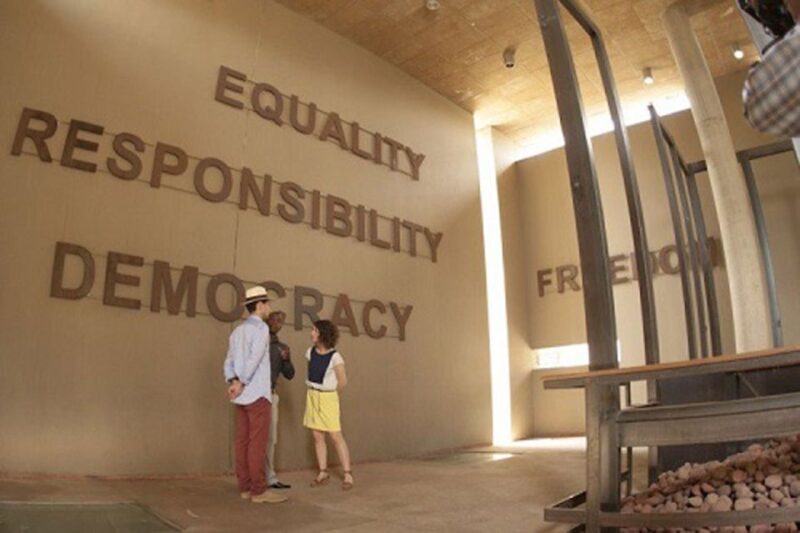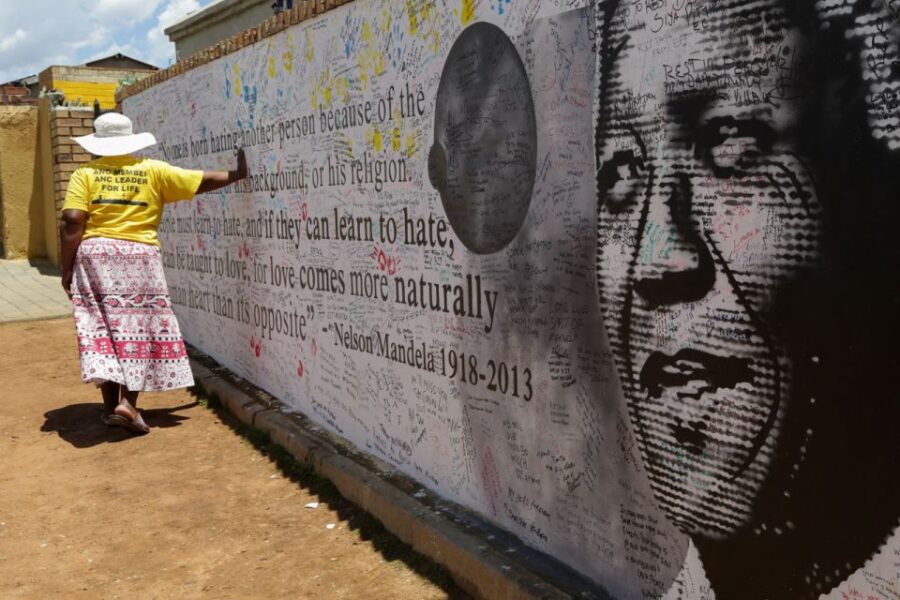The Johannesburg: Half-Day Apartheid Museum Tour takes visitors on an immersive journey through South Africa’s tumultuous history of racial discrimination and oppression. Guests explore powerful exhibits, films, and artifacts that chronicle the country’s struggle for freedom. From the Sharpeville Massacre to the Soweto Uprising, the tour provides an emotional and educational experience that fosters a deeper understanding of the nation’s path towards reconciliation. With comfortable transportation and knowledgeable guides, this tour is a must-see for anyone seeking to uncover the complexities of South Africa’s past.
Good To Know

- Comprehensive exploration of apartheid history through immersive exhibits, films, and artifacts at the Apartheid Museum in Johannesburg.
- Discover the struggle of the black majority against racial oppression and the journey towards freedom and democracy.
- Gain a deeper understanding of key events like the Sharpeville Massacre, Soweto Uprising, and Nelson Mandela’s historic election.
- Emotional and impactful experience that encourages empathy and appreciation for progress towards reconciliation.
- Convenient tour with pickup, drop-off, and an experienced guide to provide insights and adjust the schedule as needed.
Exploring the Apartheid Museum

What awaits visitors at the Apartheid Museum? An emotive and comprehensive exploration of South Africa’s troubled past.
With 22 individual exhibition areas, the museum takes visitors on a profound journey through the rise and fall of apartheid. Provocative films, photographs, text panels, and artifacts vividly illustrate the system’s events and human stories.
Guests engage with the struggle of the majority against oppression, culminating in Nelson Mandela’s historic election in 1994. Though the experience may feel too brief for some, the museum’s layout effectively evokes the emotional weight of this chapter in South Africa’s history.
Guided by knowledgeable staff, visitors depart with a deeper understanding of this complex and impactful period.
Racial Discrimination and Oppression
Apartheid, a state-sanctioned system based on racial discrimination, was implemented in South Africa in 1948.
This oppressive regime legally enforced the separation of different racial groups, denying the majority black population basic rights and opportunities. Racial segregation permeated all aspects of life, from education and healthcare to employment and housing.
The white minority government’s policies led to widespread human rights abuses, including arbitrary detention, torture, and extrajudicial killings.
The Apartheid Museum’s exhibitions poignantly convey the struggle against this injustice, culminating in the historic election of Nelson Mandela in 1994 and the end of this abhorrent system.
The Struggle for Freedom

The Apartheid Museum’s exhibits powerfully convey the unwavering resistance and courageous struggle of South Africa’s majority black population against the oppressive apartheid regime. Visitors witness the rise of grassroots movements, political activism, and international pressure that ultimately led to the regime’s demise. Key events and figures highlighted include:
| Event | Significance |
|---|---|
| Sharpeville Massacre (1960) | Sparked global outrage and condemnation of apartheid |
| Soweto Uprising (1976) | Student-led protests against inferior education for Black South Africans |
| Release of Nelson Mandela (1990) | Paved the way for democratic transition and Mandela’s election as first Black president |
| First Democratic Elections (1994) | Landmark moment, ending decades of racial oppression |
These moving displays underscore the resilience and sacrifice of those who fought for freedom.
Witnessing Apartheid’s Rise and Fall
Exploring the museum’s exhibits, visitors gain a comprehensive understanding of apartheid’s rise and eventual demise.
Through powerful film footage, photographs, and artifacts, the museum chronicles the oppressive system‘s implementation in 1948 and the decades-long struggle against it.
Guests witness the human stories that define this dark chapter, from the harsh realities faced by the Black majority to the triumphant election of Nelson Mandela in 1994.
The museum’s layout encourages an emotional journey, often leaving participants wishing for more time to fully process the weight of apartheid’s history.
More Great Tours NearbyImmersive Exhibits and Artifacts
Visitors step into a thought-provoking journey through the Apartheid Museum‘s immersive exhibits and artifacts.
The museum’s 22 exhibition areas showcase provocative film footage, photographs, text panels, and relics that vividly illustrate the events and human stories of apartheid. Guests engage with these powerful elements, feeling the weight of oppression and the struggle for freedom.
Artifacts like pass books and segregation signs bring the realities of the time into sharp focus. The emotional experience often leaves visitors wishing for more time to fully absorb the museum’s impactful content, particularly the exhibits on Nelson Mandela and Bishop Tutu.
Emotional Journey Through History
Guests embark on a profoundly emotive journey through the Apartheid Museum, confronting the realities of South Africa’s complex past.
Powerful exhibits, poignant photographs, and immersive displays evoke a range of emotions – from sorrow and anger to hope and resilience. The tour narrative skillfully weaves together personal testimonies, historical footage, and thought-provoking artifacts, leaving visitors with a deeper understanding of the struggle against apartheid.
Though the experience can feel overwhelming at times, it ultimately inspires a renewed appreciation for the hard-fought progress towards equality and justice.
Participants leave the museum with a heightened sense of empathy and a deeper connection to the ongoing journey towards reconciliation.
Tour Logistics and Accessibility
The Apartheid Museum tour provides a seamless experience from start to finish. It includes entrance to the museum and transportation in a comfortable vehicle with free Wi-Fi.
Pickup and drop-off service is provided from and to participants’ accommodations. The tour guide facilitates the experience, offering insights and adjusting the schedule based on the group’s needs.
The museum is wheelchair accessible, ensuring an inclusive exploration of this powerful historical site. With a typical tour duration of 5 hours, including 3 hours in the museum, visitors engage with the exhibits at a thoughtful pace.
Clear organization and efficient communication throughout the booking and tour process contribute to a high-quality experience.
Customer Experiences and Feedback
Typically, participants highlight the excellent tour guides and engaging museum layout in their positive experiences.
The tour consistently earns strong reviews, with a 4.3/5 overall rating from 41 customers. Participants praise the guide’s friendliness and knowledge (5/5), and the safe, well-organized transportation (4.8/5).
Plus, the tour’s efficiency, from booking to completion, is commended (5/5). However, some visitors feel the tour is too rushed, desiring more time to explore exhibits, particularly on Nelson Mandela and Bishop Tutu.
The Apartheid Museum tour receives recommendations for its informative content and well-organized logistics.
Key Customer Feedback:
- Excellent tour guides and engaging museum layout
- Desire for more time to explore exhibits, especially on Mandela and Tutu
- Overall praise for informative content and well-organized logistics
Frequently Asked Questions
Can I Visit the Museum Independently Without a Guided Tour?
Yes, visitors can explore the Apartheid Museum independently without a guided tour. The museum offers self-guided options, allowing travelers to explore the exhibits at their own pace and spend as much time as they’d like.
Are There Any Food or Dining Options at the Apartheid Museum?
The Apartheid Museum doesn’t have any onsite dining options, but there are several cafes and restaurants located nearby within walking distance. Visitors can explore the surrounding area to find a variety of food and beverage choices to enjoy before or after their museum visit.
What Are the Museum’s Hours of Operation?
The Apartheid Museum is open daily from 9:00 AM to 5:00 PM. Visitors can explore the museum’s 22 exhibition areas during these hours, seeing the history and stories of apartheid in South Africa.
Are There Any Age Restrictions or Requirements for the Tour?
The tour doesn’t have any age restrictions. Children are welcome, though the exhibits’ emotional nature may not be suitable for very young kids. The tour is open to all ages, with parental discretion advised for children.
Can I Take Photographs Inside the Apartheid Museum Exhibits?
Photography is generally allowed inside the Apartheid Museum, but visitors should be respectful and avoid using flash. Some areas may have restrictions, so it’s best to check with staff upon arrival.
The Sum Up
The Johannesburg: Half-Day Apartheid Museum Tour offers an immersive and educational journey through South Africa’s complex history. Visitors can explore powerful exhibits, witness key events, and gain a deeper understanding of the nation’s struggle against racial discrimination and its path towards reconciliation. With knowledgeable guides and comfortable transportation, the tour provides an emotionally impactful experience that fosters a greater appreciation for the country’s resilience and progress.
You can check availability for your dates here: